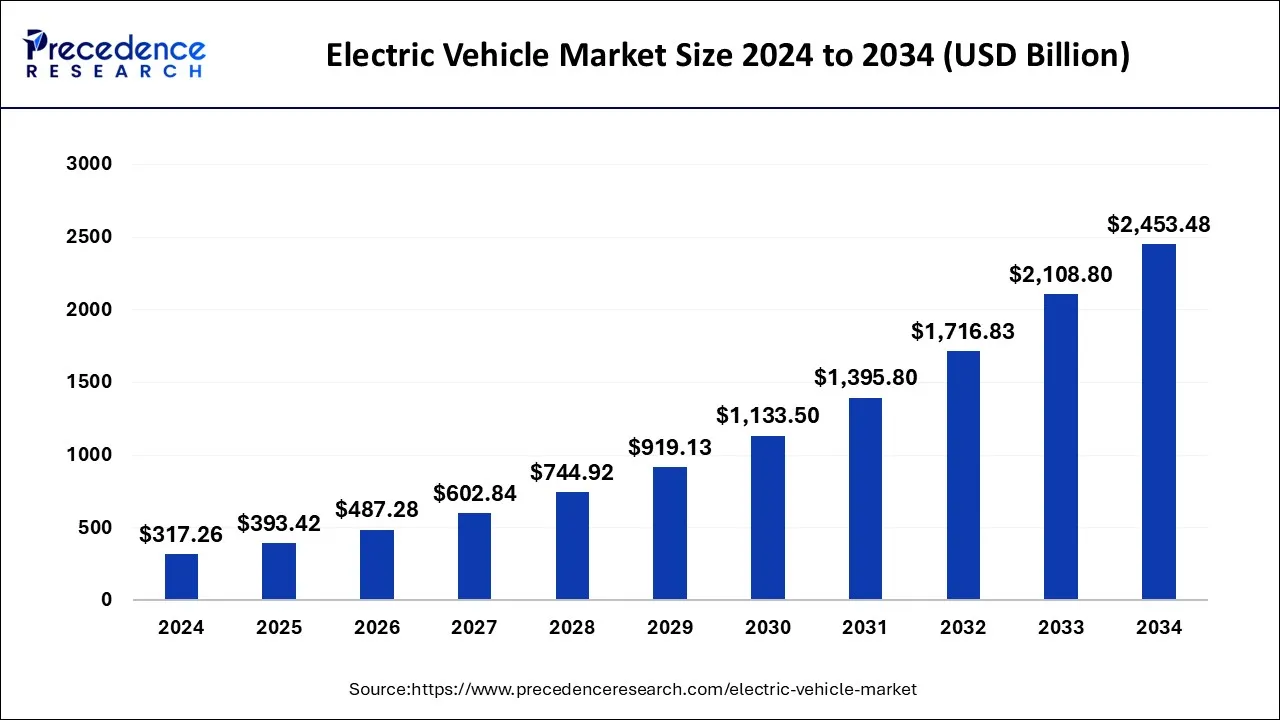Electric Vehicle Market to Reach USD 2,453.48 Billion by 2034.
Electric Vehicle Market Scope
| Report Highlights | Details |
| Market Size in 2025 | USD 393.42 Billion |
| Market Size by 2034 | USD 2,453.48 Billion |
| Growth Rate from 2024 to 2033 | CAGR of 23.42% |
| Largest Market | Asia Pacific |
| Base Year | 2024 |
| Forecast Period | 2025 to 2034 |
| Segments Covered | Propulsion Type, Components, Vehicle Type, Vehicle Class, Top Speed, Vehicle Drive, EV Charging Point Type, V2G, and Region |
| Regions Covered | North America, Europe, Asia-Pacific, Latin America and Middle East & Africa |
Market Drivers
Opportunities
- High upfront costs of EVs compared to traditional vehicles, despite falling prices.
- Limited availability of EV charging infrastructure, particularly in rural or less developed areas.
- Range anxiety and concerns about the availability of charging stations on long trips.
- Supply chain disruptions and dependency on raw materials for batteries, such as lithium and cobalt.
- The need for continuous improvements in battery efficiency and sustainability.
- Competition from traditional internal combustion engine vehicles and hybrid models.
- The slow pace of policy and regulatory frameworks in certain regions.
- Variations in consumer adoption rates across different global markets.
- Consumer perception of EVs, including concerns about battery life and performance.
Regional Insights
The electric vehicle (EV) market is seeing varied growth and adoption across different regions. Asia Pacific holds the largest share of the global market, driven by strong demand in countries like China, Japan, and India. China, in particular, is leading the global EV revolution with substantial government support, extensive EV infrastructure, and a significant push towards electric mobility. Europe is also experiencing rapid growth, fueled by stringent emission regulations and aggressive climate policies. Countries like Norway and Iceland have already made impressive strides in EV adoption, with a high percentage of new car registrations being electric. The European Union’s goal to reduce greenhouse gas emissions by 40% by 2040 and achieve net-zero emissions by 2050 is further accelerating the transition to electric vehicles.
In North America, the EV market is gaining momentum, especially in the United States, with increasing government incentives and a growing focus on sustainability. However, EV adoption in North America is still slower compared to Europe and Asia Pacific due to factors like higher vehicle costs and limited charging infrastructure. The Middle East and Africa are in the early stages of EV adoption, but efforts to diversify energy sources and develop EV-friendly policies are starting to create opportunities for growth. Latin America is gradually growing, with increasing interest in electric vehicles, but market penetration remains relatively low. Each region faces unique challenges and opportunities in EV adoption, shaped by government policies, infrastructure availability, and consumer preferences.
Read Also: Hydrogen Fuel Cell Vehicle Market
Market Companies
- Nissan Motors Co., Ltd.
- Okinawa Autotech Pvt. Ltd.
- Rivain
- Tata Motors
- Tesla Inc.
- Toyota Motor Corporation
- Volkswagen AG
- WM Motor
Recent Developments
Segments Covered in the Report
By Propulsion Type
- Hybrid Vehicles
- Pure Hybrid Vehicles
- Plug-in Hybrid Vehicles
- Battery Electric Vehicles
- Fuel Cell Electric Vehicles
By Components
- Battery Cells & Packs
- On-Board Charge
- Motor
- Reducer
- Fuel Stack
- Power Control Unit
- Battery Management System
- Fuel Processor
- Power Conditioner
- Air Compressor
- Humidifier
By Vehicle Type
- Passenger Cars
- Commercial Vehicles
- Two-Wheelers
- E-Scooters & Bikes
- Light Commercial Vehicles
- Others
By Vehicle Class
- Mid-priced
- Luxury
By Top Speed
- Less Than 100 MPH
- 100 to 125 MPH
- More Than 125 MPH
By Vehicle Drive
- Front-Wheel Drive
- Rear Wheel Drive
- All Wheel Drive
By EV Charging Point Type
- Normal Charging
- Super Charging
By V2G
- V2B or V2H
- V2G
- V2V
- V2X
By Geography
- North America
- U.S.
- Canada
- Europe
- U.K.
- Germany
- France
- Asia-Pacific
- China
- India
- Japan
- South Korea
- Malaysia
- Philippines
- Latin America
- Brazil
- Rest of Latin America
- Middle East & Africa (MEA)
- GCC
- North Africa
- South Africa
- Rest of the Middle East & Africa

